Slow Food in South Korea
An Introduction to Traditional Korean Cuisine — From Kimchi to Bibimbap
Article and Photos by Anna Maria Espsäter
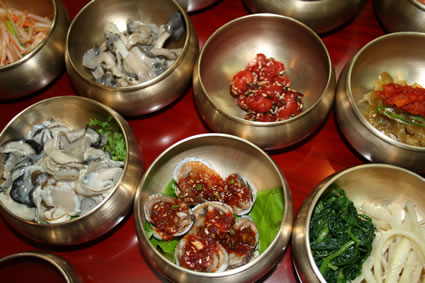
|
|
South Korean banchan.
|
My image of Korea was hazy before the visit. Wedged between its better-known neighbors, China and Japan, Korea can sometimes receive less attention than it deserves regarding international recognition. However, as a nation, it's done very well for itself. To get noticed, Korea relies on its 48 million population, who have turned a poor agricultural backwater ravaged by war into a technological and industrial giant with brand names known across the globe. Modern as Korea may seem, this is still a society with deep-rooted and age-old traditions that connect deeply to food, dining, and food preparation. My mission was to travel to sample Korean cuisine's many diverse delights nationwide.
* A quick note of explanation: Korean spelling in English varies somewhat due to the phonetics used, and for simplicity, I have used the most common versions here. This feature refers to South Korea only, and although culinary traditions are similar across the border to the North, they are unwilling to allow a journalist to roam the country in search of the perfect meal.
Cultural History and Culinary Traditions
in South Korea
Family, dedication, preparation, detail, heritage, and time play a part in Korean food. Many dishes are rather time-consuming and hail from a period when food preparation was a labor of love, usually undertaken by women. The country is quite contradictory — some 50% of marriages are arranged. There is a strict hierarchy where elders, parents, and teachers are treated with the utmost respect. At the same time, most people live in cities in glass and concrete skyscrapers, and divorce rates have soared in recent years. Traditions may have taken a knock, but deep down, no matter how modern the surface, Koreans are immensely fond of their heritage and its rituals, an eclectic and complex mix of Confucianism, Buddhism, Shamanism, and Baptism.
In most provinces, seafood is abundant along the coastline, whereas in the mountainous interior, people eat more meat. The winters are often long and harsh, particularly further north, and this has greatly influenced not just the food consumed but also the storage and pickling/fermentation processes in different regions. Culinary traditions in Korea go far back, and the country has a specific imperial cuisine, known as royal palace or royal court cuisine, stemming from the Joseon dynasty, which lasted from 1392 to 1910. In later years, this cooking became popular among ordinary Koreans and gained renown abroad. Also, numerous dishes are only made and consumed at specific times of the year, during festivities, and on special occasions. There are a wide variety of dishes that are tied to particular regions. Before tucking into some of these delicacies, look at Korean staple ingredients in a meal.
Basic South Korean Ingredients
No meal is complete without a bowl of hot, steamed rice, and this is the one dish you must finish if you don't want to seem rude. Rice is more than just a staple of a great variety of dishes and products; sweets made from different types of rice — pounded short-grain rice, glutinous rice, steamed rice, to name a few — abound, as does rice soups, mixed rice dishes such as bibimbap and of course, rice wine, liqueurs, and spirits. Almost all Korean dishes will include at least a couple of the following main seasonings and sauces: hot red chili peppers or hot red chili pepper paste (known as gochujang), soybeans or soybean paste (known as doenjang), soy sauce, sesame oil, garlic, ginger, ginseng, sea salt, scallions, and onion. The Korean diet includes meat, seafood, fish, egg yolk, tofu, and a wide variety of greens, roots, and mushrooms. Yet, the emphasis is firmly on vegetables and grains, making this a comparatively healthy nation.
Kimchi is a National Obsession
in South Korea
One tradition that defines Korean cuisine and its national character is kimchi. These chili-pickled or fermented vegetables are an obsession. There are over 160 varieties and even a kimchi museum in Korea. The word is on everyone's lips, mind, and daily ritual. If you don't learn to like kimchi, I strongly advise you to skip Korea altogether. There is no way of spending time here and not having kimchi, sometimes as often as breakfast, lunch, and dinner. But what's not to like? Kimchi is delicious, healthy, tasty, and nutritious, and the pride and joy of Korean cuisine — the national dish like no other and variations on the kimchi theme are manifold and mouth-watering. Often described simply as pickled cabbage, this is somewhat of a misnomer. Although the most common variety of kimchi is made from Chinese cabbage, imported into Korea in the 19th Century, numerous other vegetables are commonly used to make kimchi, from radishes and green onions to cucumbers and leeks. When having their photo taken, Koreans don't say "cheese" to smile; they say "kimchi." In fact, the love of kimchi is so strong that the bride is often known as "Miss Kimchi" and the groom as "Mr. Ginseng." After getting engaged, the woman has one year to learn to make perfect kimchi. If the groom isn't satisfied with her kimchi-making skills in a year, she's deemed too immature to get married!
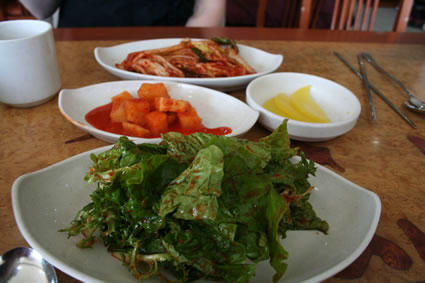
|
|
Three different types of Korean kimchi dishes.
|
The Making and Storing of Kimchi
Making the national dish is an undertaking in and of itself. Despite changing times and a society that is modernizing rapidly, some traditions remain particularly strong. It's certainly possible to buy ready-made kimchi from the supermarket. However, many households still prefer to make their own, particularly in the countryside (although over 80% of Koreans now live in cities). In cities, many neighbors get together for a kimchi-making day in the autumn, with the whole building making it together. It is an art — a woman is traditionally said to need an entire year to learn it properly, remember? It involves marinating the cabbage — or other vegetables of choice – in salt, seasoning it with brine, garlic, scallions, and ground hot red chili peppers. Still, seasoning can vary widely, and kimchi needs to be appropriately stored for it to ferment. Traditionally, kimchi would be stored outside, sometimes underground, in large ceramic jars, which can still be seen in backyards and gardens. In cities, to make things simpler, it's popular to have a special kimchi refrigerator, as the temperature has to be just right to keep the kimchi fresh and crisp tasting, even after the fermentation process.
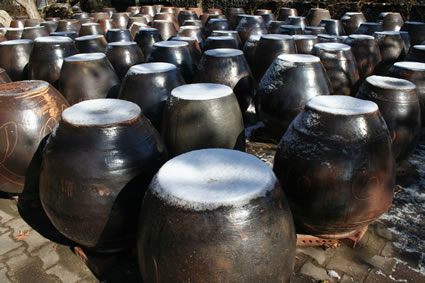
|
|
Kimchi jars covered with frost in the folk village of Suwon.
|
Banchan
Although eaten with almost every meal, kimchi is a banchan or side dish. Korean cuisine is based around these ubiquitous smaller dishes that make up an average meal. Rice, a soup — often clear — a meat or fish dish, and then a variety of smaller banchan, and your meal is complete. I started eating around Seoul, where Korean cuisine is most varied. Regional dishes, royal palace cuisine, and modern-day fusion have all found their way into Seoul's restaurants, and many take banchan to a new level.
Koreans use stainless steel or silver chopsticks, and to the relief of many Western visitors, this is much more of a spoon culture than China and Japan. The side dishes are in no way a random selection of delicious treats. Instead, they arrive in such a way as to enhance, complement, and balance each other. Korean cuisine is based on principles of balance, with solid and liquid, spicy and mild, hot and cold, working together to form the perfect meal. Certain foods are meant to go together; others should not be consumed during the same meal. Side dishes include various kimchi, served often depending on the season, e.g., young radishes in summer and a much wider variety in winter. Kimchi was traditionally a winter food staple, and many still make kimchi in preparation for winter, dating back to when fresh vegetables and greens were not available that time of year but had to be pickled and stored for the long winter months. However, these days, fresh greens and vegetables are popular side dishes. Despite its meat-eating, barbeque reputation, Korea is great for vegetarians — and even vegans — as dairy products are rare.
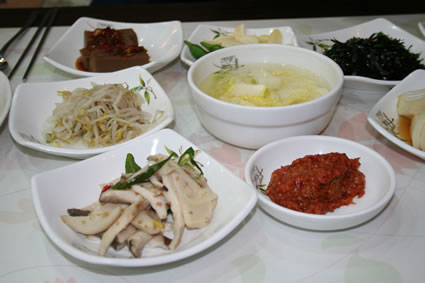
|
|
A selection of Korean banchan.
|
On the Culinary Trail in South Korea
Many South Koreans take their meals South Korean style, i.e., they take their shoes off at the entrance of a restaurant and then sit on a floor cushion in a modified lotus position, which is hard on the legs, but the quality of the food makes you forget any aches and pains instantly. Seoul has some of the best restaurants in the country, and it's pretty tempting to stay in town and munch your way from place to place. But I was determined to carry on my culinary adventure. Not far from Seoul lies the town of Suwon, home to the Korean Folk Village and an outdoor museum. Apart from giving interesting insights into Korean life in the past, it's a great introduction to kimchi jars. The Korean Folk Village in Suwon is also the setting for a top-rated South Korean drama, Dae Jang Geum, set during the Joseon dynasty and filmed on the spot. This drama has meant a resurgence of interest in Korean cooking, particularly royal palace cuisine, across the region and neighboring countries. In Suwon, I was first introduced to the traditional dish bibimbap's hot clay pot version, dolsot bibimbap. Still, it was only once in Jeonju, the birthplace of this popular rice dish, that I really began to unravel its mystery. However, let's not get ahead of our story.
Traditional Korean Barbequed Meats
After a four-hour journey by bus to Korea's third-largest city, Daegu, I found myself in the heart of Galbi country. Galbi, or barbequed beef ribs, is traditional cooking at its mouth-watering best, and the dish is eaten from a large communal pot set in the middle of the table. Generally speaking, all dishes are meant to be shared except your bowl of rice and soup. Galbi, which means" rib" in Korean, is marinated in soy sauce, garlic, and sugar, and on occasion, sesame oil, rice wine, and hot red chili pepper paste and then cooked on a grill or griddle at the table. The Daegu version arrived in a hot pot type of dish instead. It was cooked in a rather nicely spicy marinade. Another barbequed favorite is bulgogi, meaning "fire meat," and this is perhaps better known than galbi. Marinated thin slices of sirloin or prime cut of beef are grilled, often with an assortment of greens, then wrapped into lettuce or other green leaf such as sesame leaf, and eaten in one go.
The Home of Bibimbap
Our next stop on the food trail was Jeollabuk-do province and its capital, Jeonju, in the western part of Korea. This is the country's traditional heartland, and their regional bibimbap dish has almost become as synonymous with Korean cooking as kimchi and barbequed meats. This rice dish is so popular that it's served on the major airlines flying in and out of Seoul, and many variations abound throughout the country. In Jeonju, however, they make the original and best. For once, I was being made to work for my supper and had to try to cook my own dish.
At the Traditional Cultural Centre in Jeonju, there's a chance to learn Korean drumming, participate in a traditional Korean wedding — I married a Mr. Gray from St. Louis — and last but not least, have the run of their enormous kitchen. The chef showed us the ropes, and then we were left to cook on our own. Rice, the main ingredient, is boiled first. The dish includes many different vegetables, and although these can vary, my Jeonju version had cucumber, carrot, courgette, mushroom, spinach, cress, roots, tofu — all fried separately in sesame oil — and marinated minced beef. These were then placed in a bowl on top of the rice, with the colors complementing each other. In the middle, you add a generous dollop of hot red chili pepper paste and, on top, a raw egg yolk. As decoration, Korean red dates, dried and crushed seaweed, ground sesame seeds, and ginkgo nuts are placed around the yolk. By the time the dish is finished, it is a fantastic mix of color, flavor, and texture. Then, you are asked to ruin your work of art by stirring it all together.Fortunately, the mixed-up version tastes divine, with the different flavors blending to create incredible simultaneous tastes: hot and cold, mild and spicy, soft and crunchy.
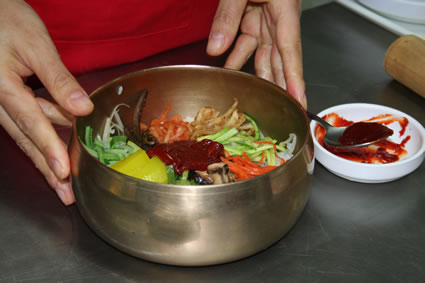
|
|
Making the Jeonju bibimbap.
|
Getting Into the South Korean Spirit of Things
Jeonju has a traditional Hanok village in the center, with 900 old-style Korean buildings. Hanok is based on the human body and endeavors to build in a way that is ideal for promoting health, considering a person's height, eye height, shoulder width, etc. One of these buildings houses the Museum of Traditional Wine and Liquor. This small museum gives a fascinating insight into Korean rice wine, liqueur, and spirit-making techniques. There is, of course, also the option — which I found duty-bound to try — of sampling the goods to gain as nuanced an understanding as possible of the process and intricacies of the products.
Alcoholic beverages in Korea vary, and 86 of them have been declared "cultural properties" by the government. The museum explicitly examines the wine and soju-making process. Soju, a rice-based spirit, could be considered Korea's national spirit and is distilled from rice wine by-products. Wines often come flavored with fruits, flowers, or medicinal herbs, and although the former taste delicious, some of the latter are an acquired taste. However, they are meant to be good for you.
|
How to Cook a Quick Bulgogi at Home
Korean food was a revelation, as pleasing to the eye as to the taste buds. I was determined to try and recreate some of the culinary wonders in my kitchen at home in England.
Ingredients:
Beef sirloin 600g, onions, scallions, mushrooms, 6 tablespoons of soy sauce, garlic, 3 tablespoons of sugar, 1 tablespoon of crushed sesame salt, 2 tablespoons of sesame oil, 1 tablespoon of ground pepper, 1 tablespoon of molasses, 1.5 tablespoons of rice wine.
Preparation:
Slice the meat thinly against the grain, then marinate in rice wine, molasses, and sugar for 30 minutes. Combine the soy sauce with minced garlic, chopped scallions, crushed sesame salt, ground pepper, and sesame oil.
Pour the soy sauce mixture over the marinated meat, covering it evenly. Pour the meat mixture into a frying pan and cook over high heat. When the beef seems almost fully cooked, add the sliced onions and mushrooms and cook until well done.
Serve with lettuce or sesame leaves for wrapping the meat mixture.
Recipe courtesy of the Korean Tourism Organization.
|
Anna Maria Espsäter, a native of Sweden has lived and worked in Holland and Mexico. She is currently based in London, where she works as a freelance food and travel writer. She is passionate about independent travel, particularly around Latin America and Asia. Having survived an earthquake, tropical disease, armed robbery, and assault while on the road, she still hasn't given up traveling and has the scars to prove it.
|
